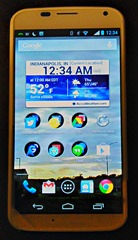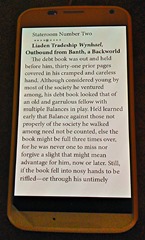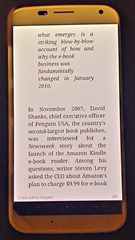 I’d previously mentioned switching to an Android smartphone with Virgin Mobile, and enjoying it as far as it went. However, lately my Virgin Mobile phone went belly-up. I’d already promised myself that when I got my new full-time job I would be switching to Republic Wireless, so this was a good opportunity. I’ve only had my new Motorola Moto X for a day or so, but I’m already pretty pleased with the phone and the service so far.
I’d previously mentioned switching to an Android smartphone with Virgin Mobile, and enjoying it as far as it went. However, lately my Virgin Mobile phone went belly-up. I’d already promised myself that when I got my new full-time job I would be switching to Republic Wireless, so this was a good opportunity. I’ve only had my new Motorola Moto X for a day or so, but I’m already pretty pleased with the phone and the service so far.
If you’ve never heard of Republic Wireless, it’s a small no-contract smartphone startup based on a clever idea. If you’re like most modern gadget users, you spend most of your time in the vicinity of at least one reliable Wi-Fi network. So why not leverage that and save some money on costly cellular service? Republic uses smartphones with a customized firmware that routes calls through voice-over-IP via Wi-Fi when available, Sprint’s 3G/4G cell network when not, and seamlessly hands off from Wi-Fi to cell if you move out of range while you’re talking.
The Service
Monthly plans are inexpensive, with no contract. If you just want to use your phone like a glorified iPod Touch and landline telephone, you can pay $5 per month for unlimited Wi-Fi only phone, SMS, and data service. For $10 per month you get that plus unlimited 3G calls and texts. $25 per month moves up to unlimited 3G calls, text, and data (where “unlimited” means 5 GB per month before bandwidth throttling—which really isn’t bad; it’s hard to rack up 5 GB of data use in a month from an untethered smartphone), and $40 per month is unlimited 4G service (same 5 GB data caveat). You can change your plan twice per month—if you’re going to have different needs part of the time, you can switch to a different plan, then switch back, and the days you’re on each plan will be pro-rated on your bill.
It should be no surprise that you can’t tether other devices to your phone—no pay-as-you-go carrier allows that, and it goes against the whole point of trying to encourage people to use Wi-Fi as much as possible. That will be a deal-breaker for some, and also means there’s not really any major advantage to the 4G plan unless you watch a lot of mobile video away from hotspots. (If you don’t use your other devices on the go that much anyway, investing in a separate pay-as-you-go MiFi for those would be most sensible.) And Sprint’s network doesn’t have the best coverage in all areas.
But for everyone else, Republic could provide ways around one of the bigger problems with cell service. Even if you’re in a no-signal area (or, for that matter, overseas), you can still make calls like you’re in your own back yard as long as you can hook to Wi-Fi. That could be useful for frequent travelers off the beaten path, or people like my parents who live in a rural area where cell service is extremely spotty. The $5 or $10 plans could also provide a cheap way for parents to give their kids limited phone service of their own, on a handy pocket-sized device that could also have educational uses at school.
The Phones
 There are currently only two models of phone available with the service: the 16 GB Moto X for $299 (or you can pay more for a customized “Moto Maker” version) and the 8 GB Moto G for $149. (The $40/mo 4G plan isn’t available for the Moto G, which has no 4G capability.) This price is between the cheap cost of a locked phone with a major carrier (of course, you’d end up paying $80 a month on a contract with one of those) and the sky-high price of an unlocked phone ($550 for the Moto X—though at $180 unlocked, the Moto G is a little less of a bargain).
There are currently only two models of phone available with the service: the 16 GB Moto X for $299 (or you can pay more for a customized “Moto Maker” version) and the 8 GB Moto G for $149. (The $40/mo 4G plan isn’t available for the Moto G, which has no 4G capability.) This price is between the cheap cost of a locked phone with a major carrier (of course, you’d end up paying $80 a month on a contract with one of those) and the sky-high price of an unlocked phone ($550 for the Moto X—though at $180 unlocked, the Moto G is a little less of a bargain).
Because of the modifications necessary for the VOIP switchover, you can’t take the phone to another carrier (though you can, of course, eBay it to someone else who wants to join Republic), nor can you bring an unlocked phone to Republic from elsewhere. (And, needless to say, there’s probably no way Apple will ever allow Republic to tinker with an iPhone ROM, so at the moment it’s Android only.) That lack of variety is a bit of a drawback, but on the other hand Republic offers two of the best phones in their price classes, so you don’t have to worry about getting confused by the availability of too many choices into picking a crappy budget phone (like my Optimus F3 from Virgin).
The Moto X
I’ve only had my Moto X for a couple of days, but already I love it. I’ve moved up from the #41 phone on Gizmodo’s list to the #2. Unlike the piddly little 1.5 GB user-accessible LG Optimus F3 I had before, this 16 GB phone has plenty of space for all the applications I want to run. It’s got a terrific, crystal clear 720P resolution screen that works great for games, video, and e-reading. There’s not a lot of carrier-mandated shovelware on it, either, like there was on the Virgin Mobile phone. It’s pretty close to stock Android. (Not surprising, given that it was made by Motorola while Motorola was still part of Google. That’s basically the next best thing to having a Google brand name on it.)
The 10 megapixel rear and 2.1 megapixel front cameras make even front-cam selfies look great, and it has a number of useful helper apps bundled with it. It has a custom camera app that’s a lot better than the one on my old phone, even if it doesn’t quite have all the features of the Kit Kat camera. And you can launch the camera even from screen lock by flicking your wrist twice. (Which is to say, you hold the phone up facing you, rotate it halfway toward facing away from you, then quickly rotate it back to face you. You do that twice in a row. It can take a couple of tries to get the hang of it.)
One interesting thing is that apparently Google’s managed to integrate Google Voice messaging into Google Hangouts now; all my Google Voice chats come through the Hangouts app, which they didn’t on my old phone.
It also has hands-free voice command capability: I can say “OK Google Now!” even when it’s locked and asleep and it springs right to life like a genie from a bottle. (It might be some time before I get tired of doing that.) Battery life seems to be about on par with my other phone.

 I also have room for all my e-reading apps, which I didn’t with the old phone. I’ve got Aldiko Premium (left), Kindle (right), Moon+, and Adobe on it right now. I haven’t had time to play around with them much, but what I’ve seen I definitely like.
I also have room for all my e-reading apps, which I didn’t with the old phone. I’ve got Aldiko Premium (left), Kindle (right), Moon+, and Adobe on it right now. I haven’t had time to play around with them much, but what I’ve seen I definitely like.
Not everything is so great about it. Like an iPhone, it doesn’t have a user-replaceable battery. Nor does it have an SD card slot, which means the 32 GB micro-SD card on which I kept a selection of music for my Optimus F3 is effectively useless. On the other hand, unlike the F3 it has plenty of memory for caching Google Play streaming. I was able to listen to my own music that I’d uploaded to my Play library pretty much all day today with the only bobble coming when I was downstairs in the parking garage at my workplace and hadn’t set up a connection to its Wi-Fi yet. So as long as I can get a signal of some kind, I can treat it like an iPod with all my musical storage in the cloud.
Another drawback to the Moto X at the moment is that, due to the necessity of customizing the firmware, it’s lagged behind its major-carrier brethren in its operating system. My Moto X has Jelly Bean 4.2.2 on it right now. However, according to a Republic rep on the site’s community forums, Kit Kat 4.4.2 is in the Sprint labs right now, and should get pushed to current Republic Moto X users within a couple of weeks to a month or so. (The newer Moto G comes with it already loaded.)
About the only thing I haven’t really tested is making Wi-Fi calls. (I just don’t call that many people.) I made one, but it was kind of flaky and soon dropped. However, I blame my wireless router for that, which has gotten rather flaky itself lately and needs replacing. Other people who’ve tried the service have reported a similar issue caused by problems with the Wi-Fi to cellular handover on their particular router, but you can disable that on a network-by-network basis.
Conclusion
Republic could be a real boon to people who want smartphone service but don’t want to have to pay through the nose for it. The $149 Moto G in particular represents a terrific value for someone on a budget. It’s a great alternative to something like the $150 Optimus F3 I bought from Virgin Mobile, both in terms of capabilities of the phone and in the cheaper monthly service. (Virgin was $35 per month.)
And the $10 per month plan means someone on a budget or who doesn’t need smartphone capability that much could get the benefit of dumbphone-equivalent service while out and about, but still use the Internet at home, libraries, or coffee shops. You can bet services like this will put pressure on the big carriers to figure out a way to match them. It would be nice if there were more variety in available phones, but on the other hand both the phones they have now are about the best choices you could possibly ask for.
If you’re interested in trying out Republic yourself, using this referral link will get you a $20 credit after your first 30 days of service. (Full disclosure: it will get me one, too.)
































I have been using Republic Wireless for about a month now and I have to say it has been smooth sailing so far. I have the Moto G and the operating system seems thus far to work flawlessly. The handoff between wifi and cell service works great. I have started calls on cell, then arrived home and I didn’t even notice until later that the service switched over to wifi. My first bill arrived and with tax, it was only $29. Less than $30 a month for unlimited phone, text and data. Gotta love it! If you need a referral code to save $20 on signup, feel free to use my link below. Cheers!
http://rwshar.es/Q4Po
I use the Moto X with Republic Wireless and it’s a good phone for a decent price at $299. The price is a lot better than elsewhere for over $500. Republic also has access to Sprint’s roaming partners so the coverage is much better than other MVNOs from Sprint. All in all, great service at an awesome price. Use this link to save $20 when you sign up! http://rwshar.es/UEbp
Or they could use the link in the article and also save $20. The difference being they’d earn me $20, too, instead of you. 🙂